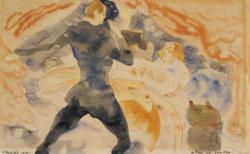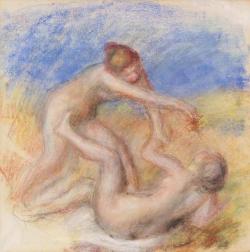Serendip is an independent site partnering with faculty at multiple colleges and universities around the world. Happy exploring!
The Girl with the Golden Eyes

Flowing. Floating. Drifting. Orange and dark blue run by, through, into each other. Like the warm ocean current from the equator meets the cold one from Arctic, crushing, fusing, solving, dissolving, creating home for diverse beautiful oceanic creatures. A man in dark clothes stands still in the waves.
Barnes Foundation, with its modern, luxurious outlook, seemed just another museum to me. I expected the inside display to be one painting per wall, so that the artworks could be given sacred majesty and be enshrined and worshiped. On the contrary, paintings are placed close together, so close that, in order to keep them from fighting for space, they are separated by huge keys, carved fences, and spearheads. Now that the artworks exist in peace and harmony, they talk and dance with each other. Two pieces of the same painter share similarity or symmetry; a huge portrait of an elderly man surrounded by smaller portraits of children like an old man surrounded by his grandchildren; an ancient African painting looks like a 19th century work; a painting and a sculpture have astonishingly similar patterns.
Two hours of viewing and searching—that was the fastest I could manage. I wrote down the ones that made me drop my jaw, and got 15 on my notebook. So I walked through the gallery quickly, laying my eyes only on the paintings I picked. Among the heavy-colored paintings with thick oil paint on the surface, these two, placed together in room 6, looked refreshing. They were like sketch, unfinished, leaving blank spaces, showing the original color and texture of the paper. There was space to breathe.

Charles Demuth (American, 1883–1935)
The Girl with the Golden Eyes (La Fille aux yeux d'or)
1916 Watercolor and graphite on wove paper
 Pierre-Auguste Renoir (French, 1841–1919)
Pierre-Auguste Renoir (French, 1841–1919)
Two Nudes
1897 Pastel and black chalk on laid paper
I first notice the lower one because it’s clearer on its subject: two nude girls. On first glance, they appear to be fighting. But in spite of their tense body gestures, the mild hue creates a relaxing and delighting mood. They are playing. The standing girl holds a crab in her hand, so maybe they are on a beach. Blue sea, yellow sand, red spots on the sand heated by the sun, and a shade of green representing the crystal clear water periodically brought to the coastline by the tides. Their skin appears silky and smooth from a swim in the sea. The brown hair of the standing girl has some yellow and green areas—maybe a flower decoration—and is tied into a bun. The lying girl’s dark hair is disheveled during the play. Their left arms are both closer to their left legs, and the right limbs are more extended, and they all interconnect—their left limbs form a small circle, and their bodies and right limbs form a bigger circle. Typically Renoir—his figures glow and blend with the surrounding—the pastel color doesn’t follow the charcoal lines, and is not even completed around the feet, but the painting still tells a recognizable story. Overall, the painting uses a diagonal composition. All is in harmony.
However, after careful observation and speculation, the upper painting attracts me more. These two paintings use similar colors, and their layouts are alike in a way that I can’t describe, but the upper one is way more dramatic, intense and contrasting. Its title totally shocks me: The Girl with the Golden Eyes. Looking carefully, I see two girls with golden hair, but I can’t find golden eyes anywhere. The upper girl’s gesture is defensive, her eyes wide open, and she’s wearing clothes and covered by a quilt; the lower girl is nude, more exposed, eyes closed, and she seems more relaxing and enjoying. I know watercolor doesn’t necessarily depict a scene in water, but this one surely feels fluid. The color fills in the lines, but I still can’t be sure of what I see. The man is standing firmly against the swirl, but it’s difficult to remain still; the upper girl is frightened by the stream, and is trying to find something to hold on to; the lower girl is floating freely and enjoying the waves. This painting leaves me with so many questions: what’s the dark thing on the lower right corner? The title is “the girl” so why put heavy color on the man but leave the girls indiscernible? Is there any other person too faint to be seen? Where are the “golden eyes”? The blurry lines form a circle that resembles the shape of an eye, but where’s the eyeball? Maybe, given the golden tone of the painting, the whole scene is seen from a girl’s golden eyes. I take off my redundant mask, let loose my hair and my body, and drift with the wave.


